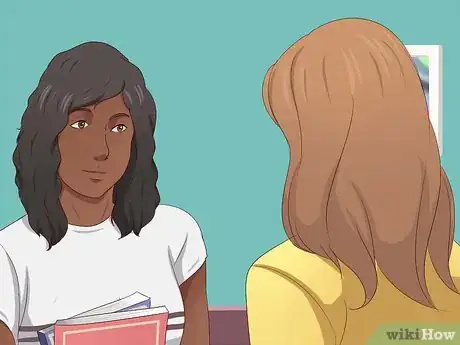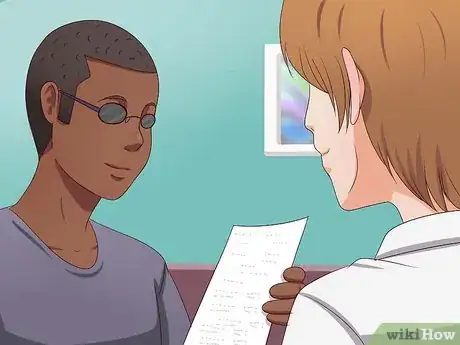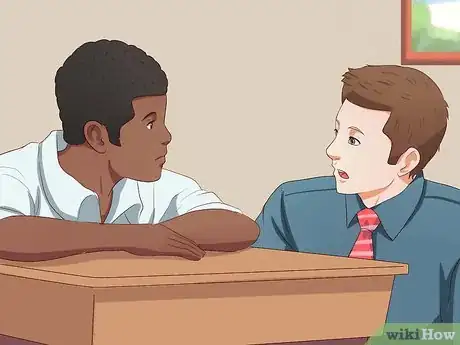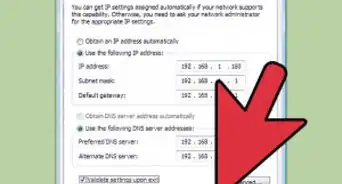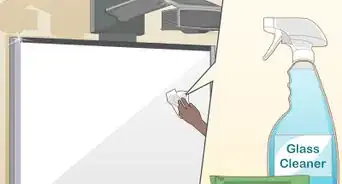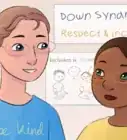This article was co-authored by Courtney Copriviza. Courtney Copriviza is an Elementary School Teacher based in Maui, HI. Courtney specializes in elementary education, classroom management, and social and emotional development. She holds a BA in Communication with a minor in Urban Education and an MA in Teaching from Santa Clara University. Courtney has also taught high school in Madrid, Spain. She is a member of Kappa Delta Pi International Honors Society in Education.
wikiHow marks an article as reader-approved once it receives enough positive feedback. In this case, 100% of readers who voted found the article helpful, earning it our reader-approved status.
This article has been viewed 71,486 times.
You must take special care when your class includes students who have physical, behavioral, and learning impairments. Promoting inclusion will require you to learn about your students' needs and create an environment that is prepared to address those needs. You may also need to restructure some of your lessons and activities accordingly.
Steps
Building an Inclusive Environment
-
1Learn about your students' needs. Get to know each student one-on-one. Your classroom may include students who have some disability and students who have none, and specific disabilities may vary among students who face them. To promote an inclusive environment, you'll need to know which needs exist and must be met.
- Keep in mind that no two disabled students are the same. Some disabilities exist on a spectrum (such as varying degrees of low vision), and others are extremely complex (such as autism). Talking to the parents/guardians, and getting to know the child, will help you understand their unique needs.
- Recognize that not all disabilities may be diagnosed yet. Sometimes, people close to the child haven't recognized that the child is different or struggling. You may have several students with unrecognized disabilities.
- Don't assume that you can defeat or cure disability.[1] Instead, work with the child at their level, and encourage them to gain skills one step at a time.
-
2Make the physical environment accessible. You'll need to use the right tools if you want to meet the needs of students in your classroom. A physical environment that is somehow “off limits” to some of your students will make it impossible for those students to learn or feel welcome.
- The exact tools will vary based on students' needs. For instance, students with vision impairments may need materials in large print or Braille. Those with speech impairments may benefit from speech synthesizers. Those with hearing loss may need a sign language interpreter and subtitled instructional videos.
- Some students will have needs that are not immediately obvious. For instance, some autistic students may have a sensitivity to light and sound, so rooms with soft light and minimal noise create a preferred learning environment.
Advertisement -
3View each student as an individual. Unfortunately, even well-meaning individuals can end up labeling disabled students by their disabilities. Instead of fixating on the things your students cannot do, focus on your students' abilities and individual accomplishments.[2]
- Viewing disabled students with pity or guilt does not empower them. Instead, you may accidentally send the message that they are less capable or less whole.
-
4Avoid assumptions. Mean-spirited assumptions aren't the only hazardous ones to watch out for. In fact, well-intended assumptions can be just as damaging and might be harder to prevent.
- If one of your students appears to need help with something, ask instead of automatically jumping in to help. Some students may prefer to work through certain difficulties themselves. Others may appreciate your help, but may also want you to help using an approach you may not have thought of.
-
5Watch your tongue. Language is important when creating the right attitude. As a general rule, use language that affirms the identity of each student while avoiding language that is considered derogatory or language that otherwise focuses on the disability instead of the individual.[3]
- Refer to disabilities in simple language free from emotional judgments. In other words, instead of saying that someone "suffers from" or "is crippled by" a given disability, it would be better to simply state that they are "a person with" that disability (or, in the case of deaf, blind, or autistic people, a "_____ person").
- Over-sensitivity can actually be harmful, too. Awkwardness over common phrases can draw unwanted attention to an impairment and may make a student feel more left out. If such phrases come up, it is best to gloss over them without making a fuss about them.
- For instance, if you or another student says "see you later" to a blind student, it is best not to point out the awkwardness of such a phrase unless the blind student indicates that they are upset by the remark.
-
6Guide student behavior. As the instructor, you must guide non-disabled students in your classroom as they interact with their disabled peers. Encourage a positive and cooperative attitude among all classmates under your care.[4]
- Pay attention to your own biases and preconceptions, then correct those errors as soon as possible. You will serve as a role model to your students, and poor behavior you demonstrate will be taught to them.
- Set ground rules regarding discussion and classroom behavior. When someone violates these rules and behaves inappropriately to another student, point out the violation and issue an appropriate consequence. Follow through consistently regardless of whether or not disabled students are involved and, if so, regardless of which position they find themselves in (i.e., the attacker or the victim). Don't enforce rules with disabled students that non-disabled students can get away with breaking.[5]
- Nip bullying in the bud. Make it clear that students need to respect others' boundaries, praise students for intervening if they see bullying, and take victims seriously if they report being bullied.
-
7Work with everyone involved. In most cases, others will be actively involved in the care and education of the disabled students in your classroom. Work directly with these guardians, counselors, and advisers when addressing those students' needs.
- Discuss your students' needs with their guardians. You may have insight to share with them, and they will almost certainly have insight to share with you.
- Depending on the circumstances, students with disabilities may need therapy from an outside specialist. These specialists may work through the school or may come from another source. Either way, it can be to everyone's benefit to communicate with such specialists when determining the best way to arrange classroom activities and instruction.
Exploring Activities to Promote Inclusion
-
1Use icebreakers. Good icebreaker activities will allow students to introduce themselves to one another in a non-threatening manner. Through these activities, students can relate to the similarities they share and appreciate the differences between them more effectively as a result.
- For younger students, consider using a simple icebreaker that requires each student to compare and contrast favorites with others in the group. Ask everyone to write their favorite of something (color, animal, food, etc.). Each student must sign their name and hand in the paper. Read the answers to the whole group without revealing the name, and ask students to guess which of their peers wrote each answer.
- For older students, form groups of three to five and instruct each group to find similarities shared by all members of the group. To encourage discussion amongst group members, these similarities should be fairly distinctive (e.g. each student has at least two siblings) instead of general (e.g. each student is a girl).
- Don't force people to speak or remember long strings of information, as this may be an access barrier. Allow people to use alternative communication (e.g. writing), and avoid games that involve memorizing facts about people.
-
2Scale down new skills. When introducing new material to students, break it down into smaller pieces and teach the skill step-by-step.[6] Doing so may make it seem less overwhelming and more accessible to everyone.
- For instance, when teaching a new skill that builds off information or skills that were taught previously, you may need to spend time refreshing your students on those previous skills before introducing the new material. As you introduce the new material, demonstrate how it connects to the information your students already know.
-
3Choose activities that address each need. Build some of your lesson plans so that they include activities and techniques that specifically address the various needs of disabled students in your classroom.[7]
- For students with speech delays, you may need to talk more while performing various activities and include activities that encourage children to develop their speech skills (singing, activities with verbal instructions, etc.). Let them use AAC if they can't do it.
- For blind or visually impaired students, you might need to verbally describe what everyone is doing during an activity and play games that involve other the senses (touch, taste, hearing, smell).
- For deaf or hard of hearing students, you may need to provide written instructions for each activity and include activities that rely on senses other than hearing.
- For autistic students and those with ADHD, anxiety, or behavioral problems, build routines and wait until students are naturally rested or relaxed before introducing new skills and challenges.
-
4Involve all participants. Make sure that the lessons you teach address all students in your classroom, including those who have disabilities and those who do not. A classroom that caters only to students with disabilities is not truly inclusive since it neglects the needs of those without.
- Depending on the circumstances, this may mean that you'll need to set different standards and parameters for each student in your classroom. Involve all students in an activity or lesson when possible, but consider altering the way that lesson must be completed for students whose disabilities would prevent them from completing it in the same way the rest of the class must. In this way, you can adequately challenge and encourage all students based on their own abilities.
-
5Modify activities when necessary. Observe the results of each activity and lesson. Prepare yourself to make changes on an “as needed” basis.[8] Make sure that you alter activities in ways that make them more effective while preserving the integrity of the overall lesson.
- Consider reducing the number of items each student must learn or complete during an assignment to better match students' abilities.
- Another option under some circumstances might be to increase the amount of time students are allowed for a certain learning task or evaluation. You may need to develop an individual schedule for each student based on his or her needs.
-
6Alter the method of instruction. In some instances, you may need to change the way you approach instruction and evaluation within the classroom. This, too, should be done only on an “as needed” basis.
- For students with learning disabilities, you may need to increase the amount of one-on-one instruction they receive from you and from classroom tutors. Make sure, however, that you are still available to other students in the classroom when they need you.
- Consider changing the way that instruction is delivered during lessons. Try different visual aids, auditory aids, and hands-on activities.
- Make accommodations easily available. If other students get jealous that a student gets to use manipulatives in math, let them use them too. This can de-stigmatize disability, and may be helpful for undiagnosed disabled students.
- Students who struggle with various forms of output may need the opportunity to express themselves in a non-standard way. For instance, students with speech impairments may need the opportunity to write a report rather than give an oral presentation.
-
7Encourage assistance and cooperation. Include activities that encourage students with disabilities and those without disabilities to work together. Both groups of students should be able to help one another.
- Consider working with other instructors and school administrators to set up peer-mentoring programs. Give older students without disabilities an opportunity to tutor or mentor younger students with disabilities. Similarly, give older students with disabilities the opportunity to mentor to younger students with and without disabilities. In all circumstances, make sure that all students involved are benefiting from the program.
Expert Q&A
-
QuestionHow can I work with an aggressive student?
 Courtney CoprivizaCourtney Copriviza is an Elementary School Teacher based in Maui, HI. Courtney specializes in elementary education, classroom management, and social and emotional development. She holds a BA in Communication with a minor in Urban Education and an MA in Teaching from Santa Clara University. Courtney has also taught high school in Madrid, Spain. She is a member of Kappa Delta Pi International Honors Society in Education.
Courtney CoprivizaCourtney Copriviza is an Elementary School Teacher based in Maui, HI. Courtney specializes in elementary education, classroom management, and social and emotional development. She holds a BA in Communication with a minor in Urban Education and an MA in Teaching from Santa Clara University. Courtney has also taught high school in Madrid, Spain. She is a member of Kappa Delta Pi International Honors Society in Education.
Elementary School Teacher Try using a behavior chart and use a small reward, such as a sticker, whenever the student exhibits good behavior to help them learn how they should properly act in class.
Try using a behavior chart and use a small reward, such as a sticker, whenever the student exhibits good behavior to help them learn how they should properly act in class. -
QuestionIs there something that can be done to the classroom building?
 Kim GTop AnswererAccording to the Americans with Disabilities Act, schools must make reasonable accommodation to ensure access to the services and facilities of the school. It can be as simple as arranging desks to make it easier for a student to navigate the classroom or installing an elevator to all access to all levels of the school building. Consult your school district if you wish to discuss reasonable accommodation further.
Kim GTop AnswererAccording to the Americans with Disabilities Act, schools must make reasonable accommodation to ensure access to the services and facilities of the school. It can be as simple as arranging desks to make it easier for a student to navigate the classroom or installing an elevator to all access to all levels of the school building. Consult your school district if you wish to discuss reasonable accommodation further.
References
- ↑ http://realsocialskills.tumblr.com/post/139118475610/how-disabled-kids-learn-to-be-suspicious-of
- ↑ Courtney Copriviza. Elementary School Teacher. Expert Interview. 18 June 2021.
- ↑ http://autismnow.org/in-the-community/promoting-inclusion/creating-inclusive-spaces/
- ↑ Courtney Copriviza. Elementary School Teacher. Expert Interview. 18 June 2021.
- ↑ https://www.realsocialskills.org/blog/autism-awareness-for-aides
- ↑ Courtney Copriviza. Elementary School Teacher. Expert Interview. 18 June 2021.
- ↑ http://www.dhss.delaware.gov/dms/epqc/birth3/files/growingtogether.pdf
- ↑ Courtney Copriviza. Elementary School Teacher. Expert Interview. 18 June 2021.
About This Article
Promoting classroom inclusion will help to meet all your students’ needs and help them feel comfortable. If you have any students with special learning requirements, make sure you have all the teaching materials you need for each class, like large print or Braille worksheets for students with visual impairments. Deal with any bullying or meanness as soon as you notice it. Teach your students to be kind and help each other with their work to create a better learning environment for everyone. When you’re teaching new skills, break them down into small steps so students who learn slower can keep up. Try to adjust your teaching style to your students’ needs. For example, for visually impaired students, you might need to verbally describe what you’re doing during an activity. For more tips, including how to avoid offending your students by saying the wrong thing, read on.
